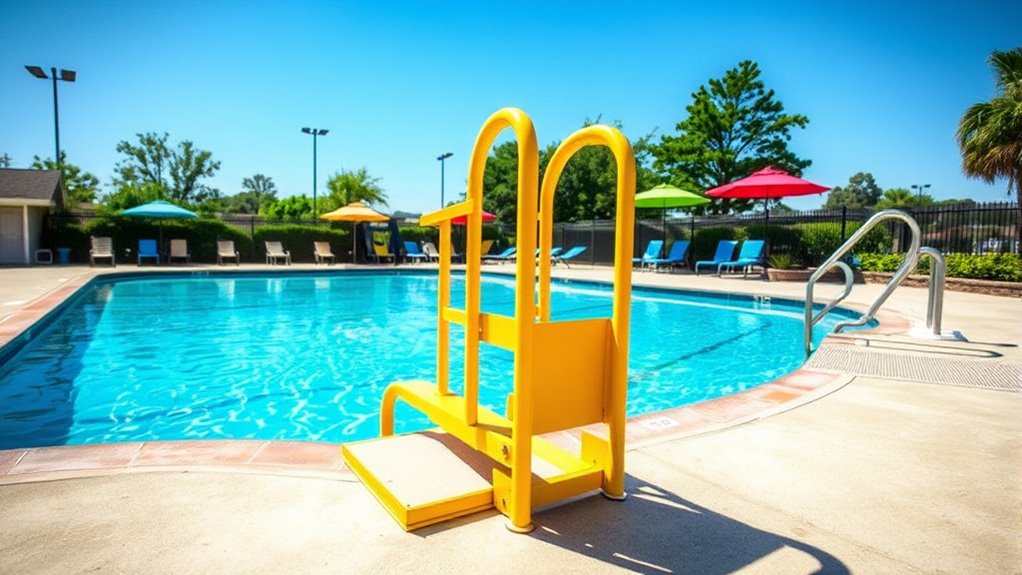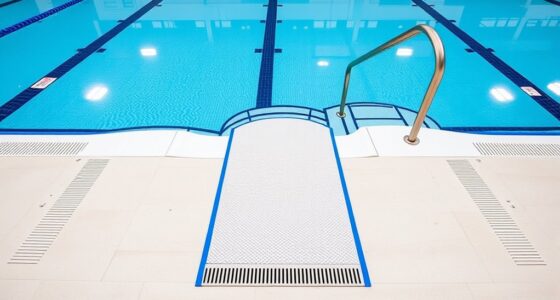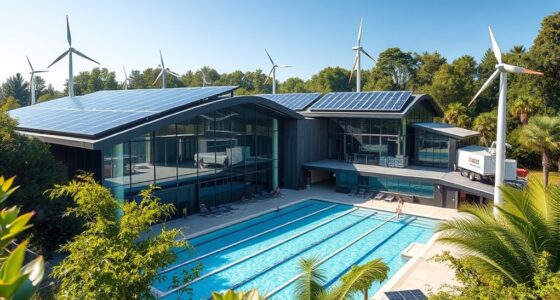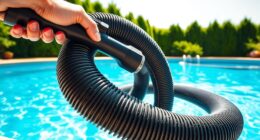Accessible community pools feature amenities like pool lifts and sensory signage to make swimming safe and welcoming for everyone. Pool lifts provide independent access for visitors with mobility challenges, while tactile and visual signs help visually impaired individuals navigate. Regular maintenance and thoughtful placement ensure these features work effectively. By adding these elements, you create an inclusive environment that promotes safety and participation for all. Discover more ways to enhance accessibility and inclusivity at your pool.
Key Takeaways
- Install pool lifts to enable safe, independent access for individuals with mobility impairments.
- Incorporate tactile and Braille signage to assist visually impaired visitors with pool rules and exits.
- Ensure accessibility features are seamlessly integrated and regularly maintained for safety and usability.
- Position equipment considering space, pool size, and surrounding environment to maximize safety and convenience.
- Promote inclusivity and safety, demonstrating commitment to a welcoming, accessible community recreational space.

Community pools are essential recreational spaces that should be welcoming and accessible to everyone. Ensuring that all individuals, regardless of mobility or sensory impairments, can enjoy these facilities is a vital part of creating inclusive environments. One of the most effective ways to achieve this is through thoughtful accessibility features, such as pool lift installations. These devices allow people with limited mobility to enter and exit the pool safely and independently. Modern pool lifts are designed to be user-friendly, durable, and easy to operate, often with simple controls that users can manage comfortably. Installing a pool lift at the right location—near the pool’s edge and in compliance with safety standards—makes a significant difference for those who might otherwise find swimming inaccessible. When you consider pool lift installations, it’s important to evaluate the pool’s size, depth, and surrounding space to ensure the lift integrates seamlessly and offers stability and security during use. Proper maintenance of the lifts is equally essential, so they remain functional and safe over time. Regular inspections and adherence to safety guidelines help ensure ongoing accessibility and safety for all users.
In addition to physical access, sensory accessibility plays a crucial role in making community pools inclusive. Braille signage is an important feature that helps visually impaired visitors navigate the pool area confidently. By incorporating Braille signage, you provide essential information about pool rules, emergency exits, and facility amenities in a tactile format that can be easily read by touch. Clear, well-placed Braille signs not only enhance safety but also foster a sense of independence for visually impaired individuals. When installing these signs, ensure they are durable, weather-resistant, and mounted at accessible heights, so they are easy to find and read. Combining tactile signage with high-contrast visual signs makes the swimming environment more inclusive for everyone.
Creating an accessible community pool isn’t just about compliance; it’s about showing care and respect for all members of your community. Pool lift installations and Braille signage are tangible steps toward removing barriers and encouraging participation. By investing in quality equipment and thoughtful signage, you demonstrate your commitment to inclusivity. Remember, accessibility features should be integrated seamlessly into the pool area, with regular checks to ensure they remain functional and effective. When you prioritize these features, you’re not only complying with legal standards but also fostering a welcoming environment where everyone feels safe, comfortable, and encouraged to enjoy the water. Ultimately, accessible community pools contribute to stronger, more connected communities where everyone has the opportunity to participate in recreational activities equally. Incorporating accessibility features not only benefits individuals with disabilities but also enhances the overall experience for all visitors.
Frequently Asked Questions
Are There Discounts for Disabled or Elderly Swimmers?
Yes, many community pools offer discount programs for disabled or elderly swimmers. You can often find senior discounts or special rates through your local recreation center or pool management. It’s best to ask directly about available discounts, as policies vary. These programs help make swimming accessible and affordable for everyone, ensuring that seniors and individuals with disabilities can enjoy the benefits of water activities without financial barriers.
How Do I Request a Custom Accessibility Accommodation?
Your request for a custom accessibility accommodation can alter your entire swimming experience! Contact the community pool’s management directly, either in person, by phone, or email. Clearly explain your needs, whether it’s assistive devices or sign language support. Be specific about what accommodations you require, and they’ll work with you to ensure you have the best experience possible. Don’t hesitate—your comfort and accessibility matter!
Are Staff Trained in Emergency Assistance for Disabled Patrons?
Yes, staff are trained in emergency response specifically for disabled patrons. They undergo regular staff training that includes emergency assistance protocols, ensuring they’re prepared to help anyone in need quickly and effectively. This training covers how to assist disabled patrons safely during emergencies, providing peace of mind for you and all community pool visitors. Rest assured, the staff’s focus is on maintaining a safe environment through proper emergency response procedures.
What Maintenance Routines Ensure Pool Accessibility Features Function Properly?
You should regularly perform pool lift maintenance to guarantee it operates smoothly and safely. Conduct accessible pathway inspections to identify and fix any obstructions or damages that could hinder access. Keep all accessibility features clean and functional by scheduling routine checks, especially before peak usage times. Promptly address issues like mechanical malfunctions or wear and tear, so disabled patrons can enjoy the pool safely and comfortably.
Can Accessibility Features Be Added to Existing Pools Upon Request?
Sure, you can add accessibility features to existing pools, even if it feels like asking for a miracle. Many communities now offer pool lift installation and tactile paving inclusion upon request. While it might seem like a hassle, these upgrades are usually straightforward and worth the effort. Just contact your local authorities or pool management, and they’ll likely be happy to help you make the pool more accessible and enjoyable for everyone.
Conclusion
So, next time you visit your community pool, don’t forget to thank the brilliantly innovative accessibility features—because nothing says progress like a wheelchair-friendly ramp or a pool lift that’s almost as sleek as your favorite gadget. Who knew that making pools accessible could be so stylish? After all, ensuring everyone can enjoy a splash isn’t just about inclusion; it’s about setting a trend you definitely won’t want to miss—because who doesn’t love a pool party that’s truly for all?









